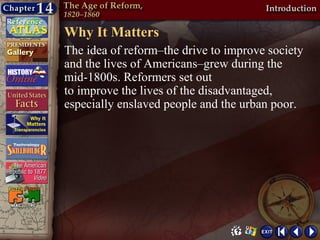
Ch. 14 2 pp
- 1. Why It Matters The idea of reform–the drive to improve society and the lives of Americans–grew during the mid-1800s. Reformers set out to improve the lives of the disadvantaged, especially enslaved people and the urban poor.
- 2. The Impact Today The spirit of reform is alive and well in the modern world. Individual freedom became a key goal during the last half of the twentieth century. Civil rights movements have advanced racial equality. In many countries the women’s movement has altered traditional female roles and opportunities.
- 3. Chapter Objectives Section 2: The Abolitionists • Describe the ways some Americans worked to eliminate slavery. • Explore the reasons why many Americans feared the end of slavery. Click the mouse button or press the Space Bar to display the information.
- 4. Early Efforts to End Slavery • Some Americans worked hard to abolish, or end, slavery during this age of reform. • The religious revival and reform movement spurred the antislavery movement. • Many of these people were Quakers. • Benjamin Lundy, a Quaker, founded a newspaper in 1821 to spread the antislavery message. (pages 418–419) Click the mouse button or press the Space Bar to display the information.
- 5. Early Efforts to End Slavery (cont.) • Formed in 1816, the American Colonization Society worked toward resettling African Americans in Africa and the Caribbean. • It was founded by white Virginians who worked to free enslaved workers by buying them from their slaveholders and sending them out of the country. - The society bought land on the west coast of Africa. - The first African Americans settled there and called the area Liberia. (pages 418–419) Click the mouse button or press the Space Bar to display the information.
- 6. Early Efforts to End Slavery (cont.) - In 1847 Liberia became independent. - Emigration continued there until the Civil War. - The society could not end slavery but could only resettle a small number of African Americans. - Besides, most African Americans did not want to resettle in Africa. - They wanted their freedom in America. (pages 418–419) Click the mouse button or press the Space Bar to display the information.
- 7. The Movement Changes • Beginning about 1830, reformers began to crusade strongly against slavery. • Abolitionist William Lloyd Garrison founded his own newspaper, The Liberator, in 1831. • He called for the “immediate and complete emancipation” of enslaved people. • People began to listen. (pages 419–421) Click the mouse button or press the Space Bar to display the information.
- 8. The Movement Changes (cont.) • African Americans played a major role in the abolitionist movement. • The African Americans of the North especially wanted to help the enslaved people of the South. • They subscribed to The Liberator, took part in organizing and directing the American Antislavery Society, and began their own newspapers. (pages 419–421) Click the mouse button or press the Space Bar to display the information.
- 9. The Movement Changes (cont.) • Frederick Douglass escaped from slavery in Maryland and settled first in Massachusetts and then New York. • He became a powerful speaker and writer, editing an antislavery newspaper, the North Star. (pages 419–421) Click the mouse button or press the Space Bar to display the information.
- 10. The Underground Railroad • The Underground Railroad was a network of escape routes to the North and then to Canada. • Abolitionists helped enslaved African Americans escape to freedom and risked prison and even death if caught. - The passengers traveled at night and rested during the day. - Early on, many people traveled on foot. - Later, they traveled in wagons, some equipped with secret compartments. (pages 422–424) Click the mouse button or press the Space Bar to display the information.
- 11. The Underground Railroad (cont.) - Even in the North, however, the runaways still feared capture. - Harriet Tubman was the most famous conductor of the Underground Railroad after escaping slavery herself. - The Underground Railroad helped only a small number of the enslaved people, and most who used it as an escape route came from the states located between the Northern states and the Deep South. (pages 422–424) Click the mouse button or press the Space Bar to display the information.
- 12. The Underground Railroad (cont.) • Opposition to abolitionism developed in the South both by people who owned enslaved African Americans and those who did not. • These people felt that abolitionism threatened the South’s way of life. (pages 422–424) Click the mouse button or press the Space Bar to display the information.
- 13. The Underground Railroad (cont.) • Opposition in the North resulted because some Northerners saw the antislavery movement as a threat to the nation’s social order. • Some felt that if freed, African Americans could not blend into American society, and some feared that the abolitionists could bring on a war between the North and the South. (pages 422–424) Click the mouse button or press the Space Bar to display the information.
- 14. The Underground Railroad (cont.) • Economic fears also contributed to the opposition because Northern workers feared that freed African Americans would take away their jobs since they would work for less pay. • Violence erupted from the opposition to abolitionists. (pages 422–424)